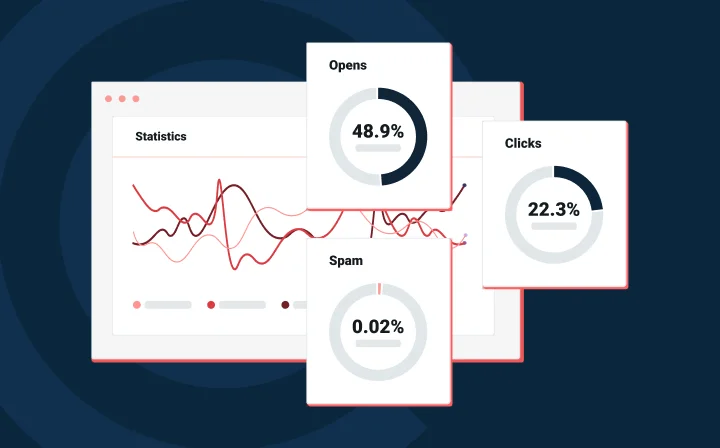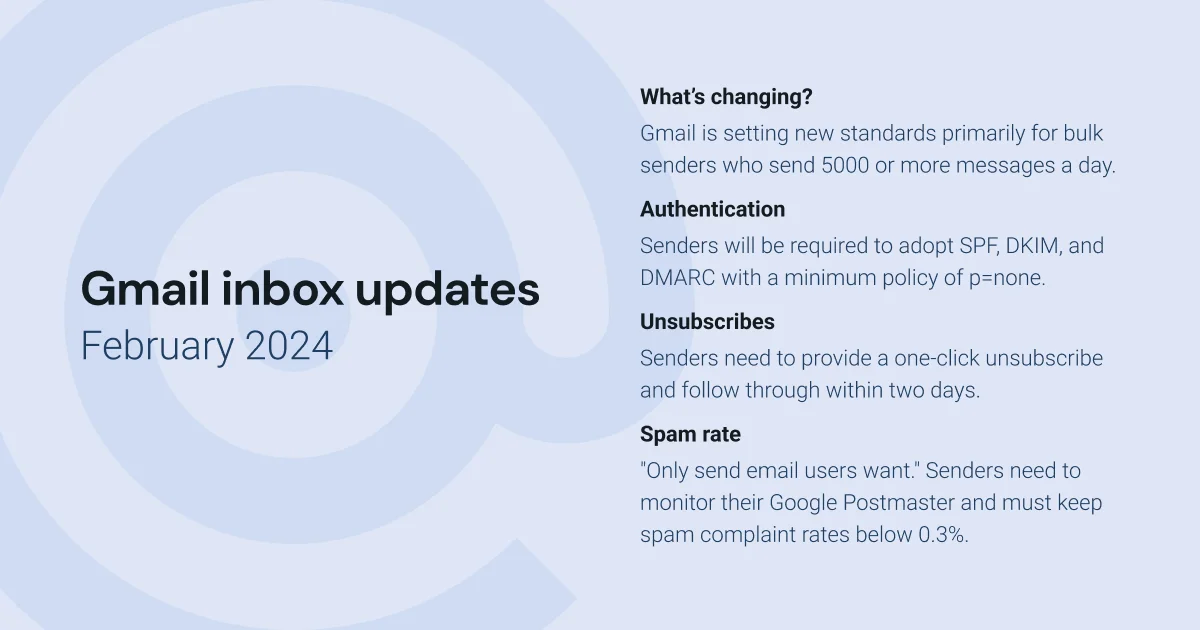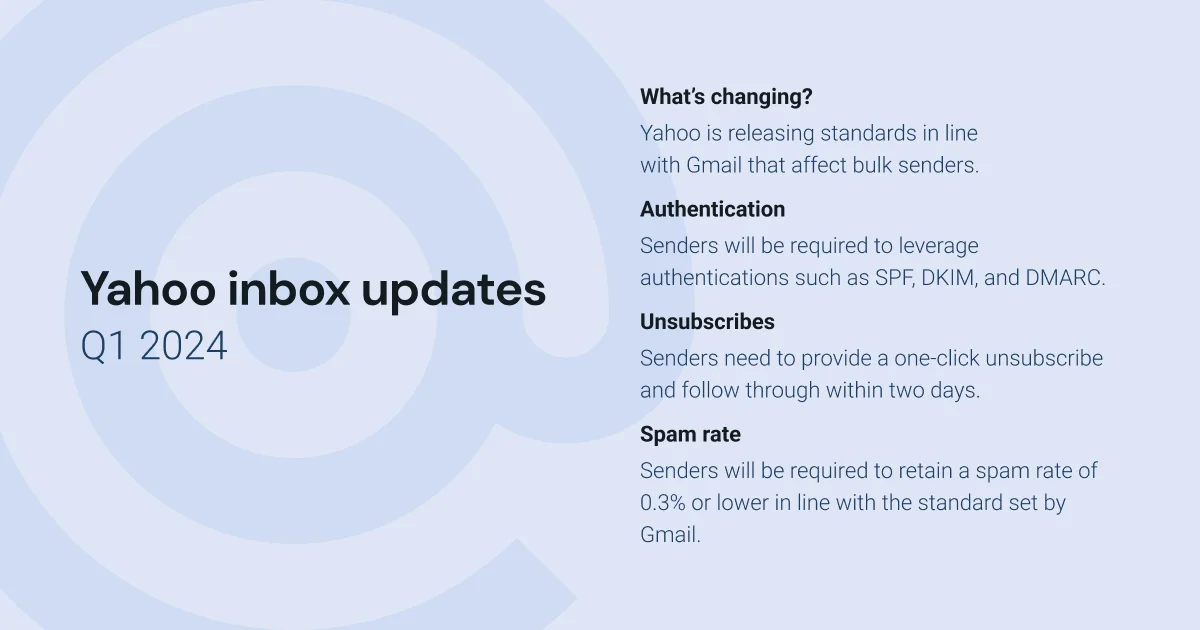Deliverability
Gmail and Yahoo’s 2024 inbox protections and what they mean for your email program

Deliverability

As senders, we should be the first to care about sending valuable, relevant emails to our contacts. Ultimately, email’s efficiency as a communications channel depends on our recipients’ overall inbox experience. More unwanted emails mean more competition and less likelihood of having our messages read.
But that doesn’t stop us from worrying when mailbox providers make the decision to enforce requirements impacting the way they handle unsolicited messages, like the ones announced earlier this month by Gmail and Yahoo.
What do these announcements really mean? How are they going to impact your email program? And most importantly, what do you need to do to stay on the right side of the email law? We’ve got all the answers and some recommendations in this post.
In an ongoing effort to secure inboxes, both Gmail and Yahoo have said that they will be enforcing new protection standards for bulk email senders.
Gmail, who had already announced a cleanup of inactive accounts in May 2023, explained in a statement that enforcement will begin in February 2024, and they’ll be carefully monitoring bulk senders (those transmitting more than 5000 messages a day). In a very similar announcement, Yahoo explained that they’ll also be targeting the first quarter of 2024.
Many bulk senders don’t appropriately secure and configure their systems, allowing attackers to easily hide in their midst.
These upcoming requirements are certainly the most substantial we’ve seen mailbox providers enforce in recent years, but they’re not new. In fact, authentication, one-click unsubscribe, and spam monitoring have been high on the list of email deliverability best practices for quite some time now.
And while it’s no surprise it has caused some concern among senders, at Sinch Mailgun we suspect requirements like these will soon spread across the industry.
The most straight forward answer to this question is that, if you haven’t already, you’ll need to get serious about certain email deliverability best practices. In fact, you should be proactive when it comes to implementing the new requirements, as Kate Nowrouzi points out in this video.
Both Gmail and Yahoo have highlighted three key changes that senders will need to prioritize if they want to be seen as legitimate senders come 2024:
These mandates will only affect bulk senders, defined by Google as senders with volumes of 5000 or more messages to Gmail addresses in one day. The announcements don’t specify that a sender must send 5000 messages each day, or within a certain time frame, though. So, it’s important to consider your peak holiday sending habits, and large campaigns when checking if these rules will apply to you. You may not think of yourself as a bulk sender, but mailbox providers might disagree.
As we mentioned before, these requirements are not unexpected or revolutionary changes in the way we should be sending emails, but they’re still not followed by many senders. For example, email authentication has been strongly encouraged for a number of years now. Still, our State of email deliverability report found that around 40% of senders are either unsure or not implementing both SPF and DKIM, and among those using DMARC, 40% are not sure what their policy is.
These changes are like a tune-up for the email world, and by fixing a few things under the hood, we can keep email running smoothly. But just like a tune-up, this is not a one-time exercise. Keeping email more secure, user friendly and spam-free requires constant collaboration and vigilance from the entire email community.
The good news is that both providers have highlighted similar updates in their statements, primarily focused on maintaining higher standards of authentication, simplifying unsubscription from promotional emails, and holding senders to a lower spam rate threshold. Here’s a snapshot of what to expect.


So, the ball is now on the email sender’s court to get ready before 2024. What changes do you need to make to ensure your emails keep landing in the inbox? And how do you implement them?
Here’s a detailed list:
Email authentication is the process of securing and confirming your sender identity through certificates and encryption. The purpose is to protect your identity against spoofing and protect your recipients from phishing attacks. This is why the Gmail and Yahoo updates focus on validating your sender identity. In 2022, Gmail began to require that senders adopt some form of authentication, which resulted in a 75% drop in unauthenticated messages received by Gmail users. But complex problems like spammers, phishers, and malware require equally complex solutions.
Gmail’s first task for bulk senders is that they authenticate their email by following these best practices. The requirement from both Gmail and Yahoo is to set up strong authentication with “ SPF, DKIM, and DMARC for your domain.” Previously not a requirement, this move towards implementing Domain-based Message Authentication, Reporting, and Conformance, (DMARC) is something Sinch Mailgun’s Jonathan Torres had already predicted in our guide on email security and compliance.
At some point, mailbox providers may decide to prioritize messages from senders that have DMARC policies set to reject or quarantine, because those are the ones they can verify and trust. We haven’t seen anyone take that step yet, but the groundwork is there to require senders to have a DMARC policy set to something besides p=none. That might be what it takes for adoption.

Our recommendation is to set up all three authentications if you are a bulk sender to protect your sender identity and your deliverability. Here’s how to go about it.
| What you’ll need | How to get there |
|---|---|
| Gmail: Both SPF and DKIM are required by Gmail. Messages that don’t carry these protocols will be rejected from the inbox or marked as spam. DMARC is also required to prevent Gmail impersonation in FROM headers. | If you’re a Mailgun user, we’ve already got you covered on SPF and DKIM. But if you’re not we’ve outlined the processes for obtaining these authentications in these posts: SPF basics and Understanding DKIM. For DMARC you will need to set at minimum a p=none policy. |
| Yahoo: Will require strong authentication and for users to “leverage industry standards such as SPF, DKIM, and DMARC”. | Implementing DMARC takes a bit more time, as DMARC allows you to make choices regarding your policy based on your email program. Get started now by checking out our Implementing DMARC article. |
There were already good reasons to provide a clearly visible unsubscribe for contacts, and an unsubscribe link in the footer text of email messages is already a standard practice across the board, that’s not what this requirement is about.
Sending messages to users who don’t want them has a major negative impact on your engagement metrics and spam rates and is ultimately bad for your overall reputation. In our podcast, Email’s Not Dead, we sat down with Marcel Becker, Sr. Product Manager for Yahoo, and asked him lots of questions about Yahoo’s new requirements.
You can check out more in our key takeaways post but here’s a preview: It’s a lot more likely that a user will unsubscribe to a message if the option to unsubscribe is visible from within the mailbox UI. Many users find it faster and easier to move a message to the spam folder than they do to scroll to the bottom of the email and complete a multi-step process.
Now, one-unsubscribe links will be even more important. From 2024, both Gmail and Yahoo will require that senders provide a single-click process for users to unsubscribe, as opposed to confirming your email or updating your subscription preferences and providing feedback. Senders will have two days to implement unsubscribe requests.
| What you’ll need | How to get there |
|---|---|
| Same for Gmail and Yahoo: A single-click pathway for users to easily unsubscribe from your messages from within the mailbox provider’s UI using list-unsubscribe headers, and internal support to honor unsubscribe requests and remove addresses from relevant email lists within 2 days. | Senders will need to put list-unsubscribe post headers into the header of their email as specified by RFC 8058. |
What’s the best way to eliminate spam from user’s inboxes? Set a low spam rate threshold and tell senders they can’t exceed it.
The strategy for both Yahoo and Gmail is the same, as is the spam complaint rate threshold of 0.3%. This may sound like a ridiculously low percentage but it’s not when you consider that many Email Service Providers (ESPs) and independent companies have existing internal practice of maintaining spam rates below 0.1%, or one message marked as spam out of every 1,000 sent.
We chose 0.3% because there are other companies and programs out there and 0.3% or below is the requirement for them already. If your traffic sustains a spam rate above 0.3%, you’re probably already in a world of hurt. Generally, we look for much smaller numbers, but 0.3% resonates with the industry so we chose to make it public.

Your spam rate, or spam complaint rate, is the number of recipients that report your message as spam compared to the total number of emails that were delivered. The best way to keep this number low is to monitor, sunset disengaged subscribers before they are tempted to press the spam button, and promptly respond to any spike in your spam complaint rate by cleaning your list and reviewing your sending practices.
Remember, Gmail doesn’t provide traditional feedback loops like Yahoo does, so you’ll need to ensure you’re signed up with Google Postmasters Tools to monitor your spam rates.
| What you’ll need | How to get there |
|---|---|
| Same for Gmail and Yahoo: The spam complaint threshold is 0.3%. | Closely monitor your spam rate, as well as other engagement metrics, using resources like Google Postmasters Tools. Employ deliverability best practices like list management and sunset policies to optimize your email lists, ensuring you’re only sending messages to engaged recipients. Use deliverability tools like Email Verification and Inbox Placement Testing to stay on top of your overall deliverability and improve your inbox placement. |
At Sinch Mailgun, email deliverability excellence is always at the core of our product offering. We’re constantly striving to set up our users for deliverability success and making sure you get the help you need to achieve it. Part of those efforts are getting the right people in the room so we can provide the most accurate information. In this spirit, Kate Nowrouzi, VP of Deliverability at Sinch Mailgun sat down with Marcel Becker, Sr. Product Manager at Yahoo, and Anu Yamunan, Director of Product for Anti-Abuse and Safety at Google, for a fireside chat to answer some of the most common questions around these sender requirements, and find out the reasons behind them.
Mailgun users can rest assured that their email authentication protocols are already compliant with Gmail and Yahoos requirements, since our platform automatically enforces both SPF and DKIM by default. For more resources, we’ve put together a library and checklist with everything you need.
We also offer a full suite of innovative deliverability tools and services designed to make these protections easy to achieve. Our Mailgun Optimize deliverability toolkit includes great tools to test, monitor, and analyze various essential email deliverability elements.
Together, these tools ultimately make it easy to stay on top of your email performance.
Think your business might need some additional support as you navigate these changes? Check out our Deliverability Services! We have a dedicated team of experts with over 320 years of combined email experience ready to help your company navigate these evolving industry standards and implement the tailored strategy that best fits your email needs.